Understanding Reef-Building Corals and Their Ecosystem Role
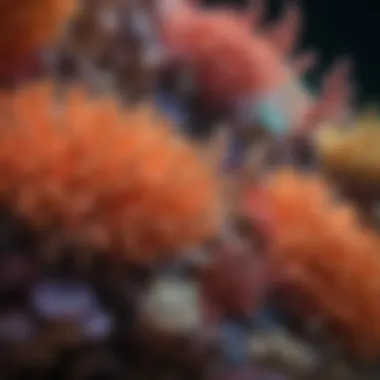
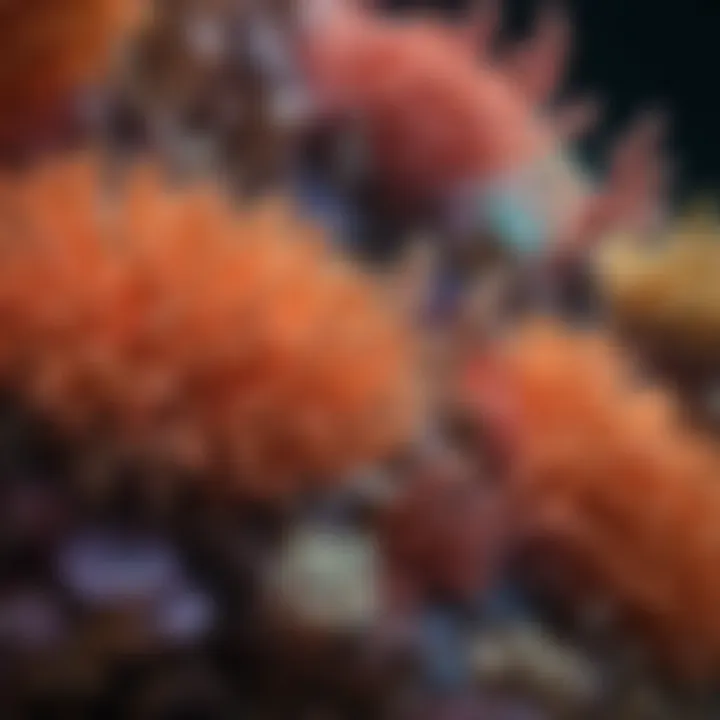
Intro
Rife with vibrant colors and teeming with life, reef-building corals create some of the most magnificent ecosystems on the planet. These incredible organisms, while often mistaken for mere rocks, are actually dynamic living structures that serve as the backbone of coral reefs. This discussion will peel back the layers—figuratively speaking—of these fascinating entities, shining a light on their biology, ecology, and the intricate relationships that define their existence.
Despite their beauty, corals face mounting threats from various sources like climate change, pollution, and overfishing. Understanding the roles they play in the ocean's delicate balance is paramount. Not only do they contribute to marine biodiversity, but they also act as indicators of ocean health, offering insight into the broader conditions of marine environments.
As we navigate this exploration, the aim is to absorb as much knowledge as possible, fostering a mutual appreciation for these marine wonders and recognizing the urgent need for effective conservation strategies.
Prologue to Reef-Building Corals
The intricate nature of reef-building corals cannot be stressed enough. They stand as not just colorful decorations beneath the waves but as vital players in marine ecosystems. These tiny organisms, known as polyps, play a pivotal role in creating coral reefs, structures that serve as habitats for countless marine species. Their existence is intertwined with human life too, as these reefs protect coastlines from erosion, support fisheries, and contribute to tourism.
Understanding why reef-building corals are essential is the first step in grasping the broader implications for biodiversity and ocean health. They act as natural barriers against storms, and without them, coastal areas could face more severe flooding and damage. In short, they’re nature's first line of defense. Additionally, these ecosystems provide food and nursery grounds for various fish species, making them crucial for fisheries around the world. It's this interdependence among species that contributes significantly to the overall biodiversity of oceans.
Definition and Importance
Reef-building corals, or stony corals, are marine invertebrates that form calcium carbonate structures. These structures become the foundation of reefs, providing not only a physical habitat but also a thriving environment for other marine life. They are more than static organisms; they engage in numerous biological processes that sustain the aquatic ecosystems where they live.
The importance of corals extends into various realms:
- Economic Value: Coral reefs contribute billions to the global economy by supporting fishing and tourism.
- Ecological Balance: They provide shelter and food for diverse marine life, acting like bustling cities beneath the sea.
- Climate Regulation: Healthy reefs play a role in carbon cycling and can help moderate local climate effects.
"Coral reefs are to the ocean what rainforests are to the land; they are incredibly rich in diversity, but also extraordinarily fragile."
Distribution and Habitat
Coral reefs flourish in warm, shallow waters, primarily between the Tropic of Cancer and the Tropic of Capricorn. However, their distribution is not uniform; certain areas have higher concentration and diversity, often referred to as biodiversity hotspots. The Great Barrier Reef off the coast of Australia is the most renowned example, showcasing a spectacular array of coral species and marine life.
Coral habitats can be categorized into various types:
- Fringing Reefs: These are narrow bands of coral formed close to the shoreline, separated by shallow lagoons.
- Barrier Reefs: Located farther from shore, these reefs face the open ocean and are separated by deeper channels.
- Atolls: These are ring-shaped reefs that encircle lagoons, formed around subsiding volcanic islands.
Each habitat supports unique ecosystems and signifies the adaptability of corals in different environmental conditions.
In summary, reef-building corals serve as keystones in their ecosystems, and their distribution is vital for maintaining marine biodiversity. Understanding their role offers insights into the complex web of life that thrives in the oceans and highlights the urgent need for their conservation.
The Biology of Coral Structures
The biology of coral structures is fundamental to understanding how reef-building corals thrive in their environment. This section will focus on several key elements that are critical in shaping these remarkable organisms. By examining the intricate details of their morphology, the formation of their calcium carbonate skeletons, and their growth patterns, we can appreciate not just the beauty of coral reefs but also their essential role in marine ecosystems.
Morphological Diversity
Corals exhibit a dazzling array of morphological diversity. Each species, from the branching Acropora to the massive Porites, showcases unique adaptations that allow them to survive and thrive under varying environmental conditions. This diversity is not merely aesthetic; it plays a crucial functional role.
Some corals create complex structures that provide shelter and habitats for various marine species while others contribute to the overall resilience of the reef.
They can be broadly classified into two groups: hard corals and soft corals. Hard corals primarily build the reef structures through their calcium carbonate skeletons, while soft corals, although they lack significant hard structures, still play a vital role in energy flow and habitat complexity.
"The health of a coral reef can often be gauged by its diversity – not merely of coral species but the entire range of life it supports."
Calcium Carbonate Skeleton Formation
Central to the life of reef-building corals is the process of calcium carbonate skeleton formation. This process begins when coral polyps extract calcium ions and carbonate ions from seawater. Through a biochemical process, they combine these ions to create calcium carbonate, which forms the rigid skeleton that provides structure and support.
This skeleton serves multiple purposes, such as:
- Protection: The sturdy skeleton guards against predators and environmental stresses.
- Growth: As polyps divide, they add new layers to the existing structure, allowing the reef to expand over time.
- Habitat: The complex structure formed by corals offers myriad niches for marine organisms, fostering biodiversity.
Understanding this process is vital, especially in the context of increasing ocean acidification, which threatens the availability of the necessary ions for skeleton formation.
Growth Patterns
Coral growth patterns are as diverse as the species themselves. The rate and nature of growth depend on various factors including species, environmental conditions like light and nutrient availability, and space on the reef.
Some corals grow rapidly, creating extensive reef structures in a matter of years, while others take centuries to form significant accumulations.
Factors influencing growth include:
- Environmental Conditions: Warm, shallow waters with plenty of sunlight and nutrients foster rapid growth.
- Competition: Space on the reef is valuable, leading to competitive growth strategies. Some corals may grow taller to overshadow others, while others may spread laterally to occupy available space.
- Resilience: Following disturbances, corals can adopt different growth patterns to recover, from fast growth to increased reproduction rates.
These growth dynamics are crucial to the resilience of coral reefs, as they adapt to changing conditions and disturbances. An understanding of these patterns is imperative for effective conservation efforts as we strive to protect these vital ecosystems.
Symbiotic Relationships in Coral Reefs
Symbiotic relationships form the backbone of coral reef ecosystems, enabling these vibrant organisms to thrive in often challenging environments. The collaboration between reef-building corals and their symbiotic partners is fundamental for their survival and ecological success. Understanding these relationships not only highlights the complex interactions within reef ecosystems but also underscores the broader implications for marine biodiversity and resilience. In this section, we delve into the intriguing dynamics of the partnerships formed in coral reefs, particularly focusing on how these interactions drive both the growth and sustainability of these ecosystems.
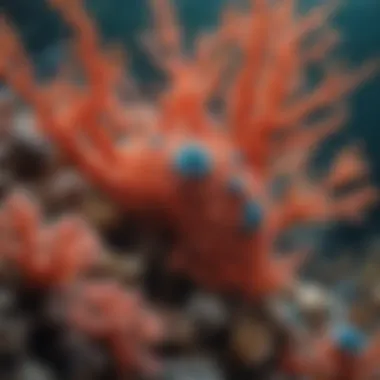
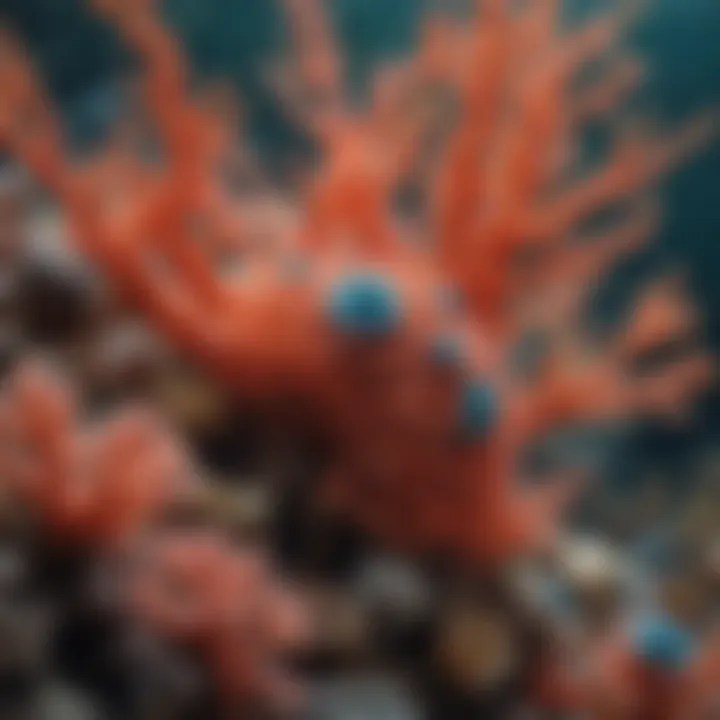
Zooxanthellae: The Photosynthetic Partners
At the heart of coral symbiosis are zooxanthellae, microscopic algae that reside within the coral's tissues. These dinoflagellates are not just freeloaders; they play a crucial role in the survival of coral reefs. Through photosynthesis, the zooxanthellae convert sunlight into energy, producing organic compounds that serve as a primary food source for the coral host. This is a brilliantly efficient arrangement. The coral, in turn, provides a safe haven and essential nutrients for the zooxanthellae, creating a mutually beneficial relationship.
The presence of these algae gives corals their brilliant colors — a sight that often mesmerizes divers and researchers alike. When coral reefs suffer from stress, particularly from rising sea temperatures, they can expel these algae in a process known as bleaching. Without their partners, corals lose not only their color but a significant source of sustenance, making them vulnerable to stress and mortality.
Nutrient Exchange Dynamics
The relationship between corals and zooxanthellae goes beyond just food production. Nutrient exchange is a dynamic process essential for maintaining the health of the coral reef ecosystem. These algae not only provide energy; they also play a pivotal role in nitrogen and carbon cycling, both vital nutrients for coral growth.
- Coral Perspective: Corals take in organic molecules and oxygen produced by zooxanthellae, which helps them grow and reproduce effectively. This is especially important in nutrient-poor, tropical marine environments where they are often found.
- Zooxanthellae Perspective: The algae thrive on the waste products generated by the coral, such as carbon dioxide and ammonium, which are essential for their photosynthetic processes. This symbiotic system can be viewed as a finely tuned engine where both partners contribute to a balance that sustains their existence.
Through these interactions, corals can not only survive but flourish in environments where other organisms might not be able to. By maintaining this balance, coral reefs act as biodiversity hotspots, hosting numerous marine species, all of which contribute to the overall health of the ocean.
In summary, the symbiotic relationships in coral reefs are intricate and vital for their survival. The interplay between corals and their zooxanthellae illustrates the delicate balance of life in marine ecosystems, highlighting how these interactions can either fuel growth or lead to decline in the face of environmental shifts.
"The health of coral reefs is a testament to the intricate relationships that sustain them, reflecting the delicate balance of nature's design."
Understanding these relationships is paramount, particularly as coral reefs face numerous threats from climate change, pollution, and habitat destruction. Continued research and efforts to protect these ecosystems can ensure their survival for generations to come.
Ecological Importance of Coral Reefs
Coral reefs, often called the "rainforests of the sea," are vital to the health of our oceans and offer a myriad of benefits beyond their astonishing beauty. They serve as essential habitats for a diverse range of marine life, contributing to both biodiversity and the stability of marine ecosystems. Estimations suggest that coral reefs support roughly 25% of all marine species, despite covering less than 1% of the ocean’s surface. This statistic underscores not just the sheer diversity housed within these underwater landscapes but also their significance in terms of ecological balance.
One of the defining features of coral reefs is their role as biodiversity hotspots. These ecosystems shelter numerous species, providing not only food and shelter but also breeding grounds for various marine organisms. Some species are dependent on corals for their lifecycle stages. For instance, many fish larvae seek refuge among the intricate nooks and crannies of coral, which offer protection from predators.
Additionally, coral reefs have a substantial impact on the productivity of the oceans. The complex food web they support helps sustain larger species, including commercially important fish and other marine creatures. As such, healthy coral reefs are directly linked to the livelihoods of millions of people who rely on fishing.
Moreover, coral reefs also contribute significantly to coastal protection. They act as natural barriers against wave action, storms, and coastal erosion, safeguarding shorelines and human settlements. The physical structure of reefs reduces wave intensity, thus lessening the impact of storms on coastal communities.
Biodiversity Hotspots
The complex interplay of coral species, algae, and marine life within these reefs creates an environment rich in species diversity. Coral reefs are not merely collections of coral; they are bustling ecosystems teeming with life. Some of the specific benefits of biodiversity in coral reefs include:
- Habitat for Marine Species: Many organisms, from tiny shrimp to large predators, find their homes among corals. Each species plays a role, contributing to the overall health of the ecosystem.
- Genetic Diversity: The variety of species within coral reefs enhances their resilience to changing environmental conditions. If one species decreases due to stress, others may thrive, helping to maintain ecological stability.
- Medicinal Resources: The genetic material present in reef organisms has significant potential for medical research. Compounds derived from coral-associated species can lead to breakthroughs in cancer treatments and other medicines.
The uniqueness of each reef contributes to the larger picture of our planet's biodiversity. Notably, some coral species have adapted to environmental extremes, showcasing nature's astonishing inventiveness.
Coastal Protection and Ecosystem Services
Coral reefs provide vital ecosystem services that go beyond their beauty. In particular, their role in protecting coastlines cannot be overstated. Here are key aspects of their protective capabilities:
- Wave Resistance: Coral reefs buffer coastlines from wave energy, reducing erosion and damage from storms. This action acts like a shield, absorbing and dispersing the energy of incoming waves.
- Sediment Stabilization: By trapping sediments, coral reefs help maintain the clarity of coastal waters, allowing sunlight to penetrate deeper, which is essential for photosynthesis by the reef's symbiotic algae.
- Tourism and Recreation: Healthy coral reefs attract tourists, supporting local economies. Activities like snorkeling and diving heavily rely on the allure of vibrant reef ecosystems, thus creating jobs and generating income.
- Carbon Sequestration: Coral reefs also play a role in capturing carbon from the atmosphere, offering a natural mechanism to help combat climate change.
Understanding these benefits highlights the necessity for effective conservation efforts. To protect our coral reefs is to protect biodiversity, coastal communities, and the myriad of services they provide.
"Coral reefs, as vibrant ecosystems, not only sustain marine life but also safeguard coasts and support human livelihoods."
In closing, the ecological importance of coral reefs extends far beyond their aesthetic appeal. They are, quite literally, the lifeblood of our oceans, underpinning the health of marine environments and offering protection for coastal areas. As we delve deeper into this complex world, it becomes clear that our actions have far-reaching implications for these magnificent structures and the myriad of life they sustain.
Environmental Stressors Affecting Corals
The health and survival of reef-building corals are inextricably linked to their environment. Corals are not simply passive inhabitants of the ocean; they are dynamic organisms that respond to a myriad of environmental stressors. Understanding these stressors is crucial, not just for preserving coral reefs but also for maintaining the broader ecological balance of marine ecosystems. In this section, we will dissect the specific challenges posed by climate change, ocean acidification, pollution, and habitat destruction. Each stressor operates on various levels, impacting coral health individually or interacting together to compound their effects.
Climate Change Impacts
Climate change stands as one of the most pressing threats to coral reefs worldwide. As global temperatures rise, so do sea temperatures, which can lead to mass coral bleaching events. Bleaching occurs when corals expel the zooxanthellae algae that live within their tissues, responsible for not only giving corals their vibrant colors but also providing them with essential nutrients through photosynthesis. Without these algae, corals starve and lose their ability to recover from other stressors.
"A single degree can mean the difference between survival and demise for many coral species."
The ongoing rise in ocean temperatures has altered distribution patterns for various coral species and affected their reproductive cycles. In addition to temperature, increased frequency of extreme weather events, like hurricanes, can physically damage coral structures and ecosystems. Thus, the ramifications of climate change are profound and multifaceted, requiring immediate and sustained action to mitigate its effects.
Ocean Acidification
As the atmosphere heats up, oceans absorb more carbon dioxide, leading to a decrease in pH, resulting in ocean acidification. This reduction in pH levels has dire consequences for calcifying organisms, such as corals. Corals rely on calcium carbonate to build their skeletal structure. More acidic waters impair their ability to produce this crucial material, hampering growth and resilience.
The effects of ocean acidification are not limited to stunting coral growth. The weakened structures make corals less able to cope with stresses from other sources like storms or predation. Research indicates that certain species of corals are particularly vulnerable, potentially leading to shifts in community structures within reef ecosystems.
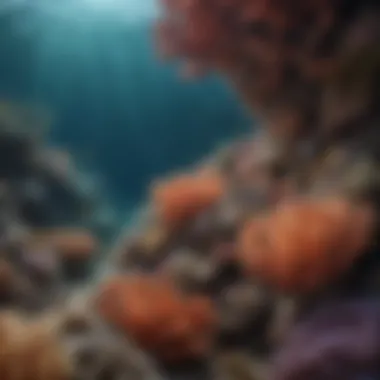

Pollution and Habitat Destruction
Coral reefs face significant threats from pollution—both from land-based sources and marine activities. Nutrient runoff from agriculture, sewage discharge, and plastic waste can lead to algal blooms, which outcompete corals for space and resources. The resulting degradation of water quality affects coral health and resilience.
Alongside pollution, habitat destruction not only from human activities but also from dredging and coastal development plays a major role in coral decline. When coastal areas are altered, the ecosystem dynamics are thrown into disarray; organisms that rely on coral reefs for shelter and sustenance may suffer or perish, further weakening the ecosystem.
To summarize, the multitude of environmental stressors affecting corals—especially climate change, ocean acidification, pollution, and habitat destruction—paint a grim picture for reef ecosystems. Understanding these challenges is essential not just for researchers but also for policymakers and local communities looking to protect these invaluable marine resources.
Coral Bleaching Phenomenon
Coral bleaching serves as a crucial topic in understanding the dynamics of reef-building corals. At its core, this phenomenon reflects the distress facing corals in the changing marine environment. When environmental stressors such as elevated water temperatures, pollution, or changes in salinity occur, corals expel their symbiotic algae known as zooxanthellae. This expulsion leads to a whitish appearance, or "bleaching," which not only affects the aesthetic beauty of reefs but also has dire implications for marine ecosystems.
Causes and Mechanisms
The causes of coral bleaching are predominantly tied to environmental shifts. The primary driver is often the rise in ocean temperatures, averaging just a few degrees above normal. This stress response isn't sudden; it is a gradual process that kicks in when temperature anomalies persist over weeks or months.
Additionally, variability in ocean chemistry plays a part. Increased levels of carbon dioxide result in more acidic waters, reducing the coral's ability to maintain their calcium carbonate structures. Other significant factors include pollutants, such as agricultural runoff, which can lead to algal blooms that starve corals of necessary light.
Below are the main contributors to coral bleaching:
- Increased sea surface temperatures: Exceeding the normal temperature ranges, even slightly, can trigger bleaching.
- Ocean acidification: A decrease in pH due to excess carbon dioxide impacts coral health and growth.
- Pollution: Nutrient-infused runoff can lead to algal blooms which can block light necessary for coral survival.
- Overexposure to sunlight: Stress from prolonged exposure, especially post-bleaching, can inhibit recovery efforts.
"Coral reefs are among the most vulnerable ecosystems on Earth, and their health is indicative of the overall health of ocean environments."
Recovery Processes and Limitations
The recovery of corals from bleaching events is a complex dance between resilience and vulnerability. Some corals can regain their symbiotic algae if normal conditions return swiftly. However, this process isn't as simple as flipping a switch. Factors such as the degree of stress endured, the duration of the bleaching event, and the specific species of coral all contribute to different outcomes.
- Environmental stability: Stability in temperature and water chemistry is critical for corals to recover their lost zooxanthellae.
- Genetic factors: Some coral varieties have genetic make-ups that enable them to withstand stressors better than others.
- Timeframe: Recovery can take years or even decades, depending on the severity of the bleaching and subsequent conditions.
Yet, threats linger in the form of persistent stressors that compromise recovery chances. For instance, continued global warming could set the stage for further bleaching events before corals have a chance to rebound. Additionally, cumulative stress from pollution could stymie their ability to recuperate.
In summary, while coral bleaching highlights a critical warning system for marine health, understanding its causes and recovery mechanisms is vital for effective conservation strategies moving forward.
Conservation Efforts for Coral Reefs
The conservation of coral reefs holds significance beyond simply safeguarding a species; it is about preserving a complex ecosystem that supports myriad marine life and promotes ocean health. Reef-building corals are integral to the overall structure of marine biodiversity. However, these living entities face myriad threats, such as climate change and coastal development. Hence, robust conservation efforts have become vital. By understanding how these efforts can help, one can appreciate their relevance to coral ecosystems and the greater marine world.
Marine Protected Areas (MPAs)
A cornerstone of coral conservation is the establishment of Marine Protected Areas. MPAs are designated regions where human activity is restricted to various extents in order to preserve the natural resources and biodiversity. These spaces offer a refuge to coral populations and allow for the restoration of depleted fish stocks, which are crucial for maintaining a healthy reef structure.
- Key Benefits of MPAs:
- Biodiversity Protection: MPAs serve as sanctuaries for vulnerable marine species.
- Habitat Resilience: Coral within these areas may exhibit greater resilience to environmental changes, supporting recovery after events like bleaching.
- Scientific Research: MPAs provide living laboratories for scientists to conduct research on marine ecosystems, offering insights that might not be observable elsewhere.
The design and management of MPAs require consideration of ecological, social, and economic factors. Stakeholder involvement and local fisheries are crucial aspects of MPA programs to ensure that conservation measures are effective and sustainable.
Restoration Techniques
In addition to MPAs, active restoration techniques play an essential role in revitalizing coral reefs. These strategies seek to rebuild damaged ecosystems by introducing healthy coral specimens into degraded areas.
Among the innovative restoration techniques are:
- Coral Gardening: Involves the cultivation of coral in nurseries before reintroducing them into their natural habitats.
- Microfragmentation: This method accelerates growth by breaking coral into smaller pieces, which can recover much faster than whole colonies.
- Assisted Gene Flow: This emerging strategy consists of relocating coral from warm-water habitats to cooler locations, potentially fostering resilience against rising sea temperatures.
These techniques are not without challenges. For instance, achieving successful coral transplanting often depends on monitoring and ensuring the survival of the introduced specimens while combating adverse conditions such as pollution and nutrient runoff.
Community Involvement and Education
Lastly, effective conservation is impossible without community involvement and education. Local communities often hold valuable indigenous knowledge, understanding the unique relationships between coral reefs and their surrounding environments. Engaging these communities in conservation initiatives enhances the efforts' success.
- Educational programs can help raise awareness about coral ecosystems' plight and the significance of maintaining them.
- Volunteering opportunities, such as beach clean-ups and reef surveys, foster a deeper connection between residents and their marine environment.
- Citizen science initiatives empower individuals to contribute to data collection, assisting scientists while building community spirit around coral conservation.
Ultimately, involvement at the community level can transform awareness into action. As stakeholders in the health of marine ecosystems, local populations can champion conservation efforts through grassroots movements, advocacy, and sustainable practices.
Conservation efforts for coral reefs blend scientific, communal, and regulatory contexts to tackle the multifaceted challenges faced by these ecosystems. In this convergence, the unity of purpose can pave the way for hopeful futures for corals and the vast biodiversity they support.
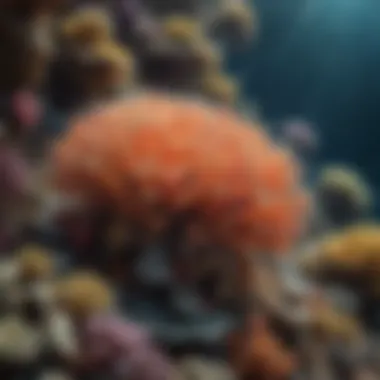
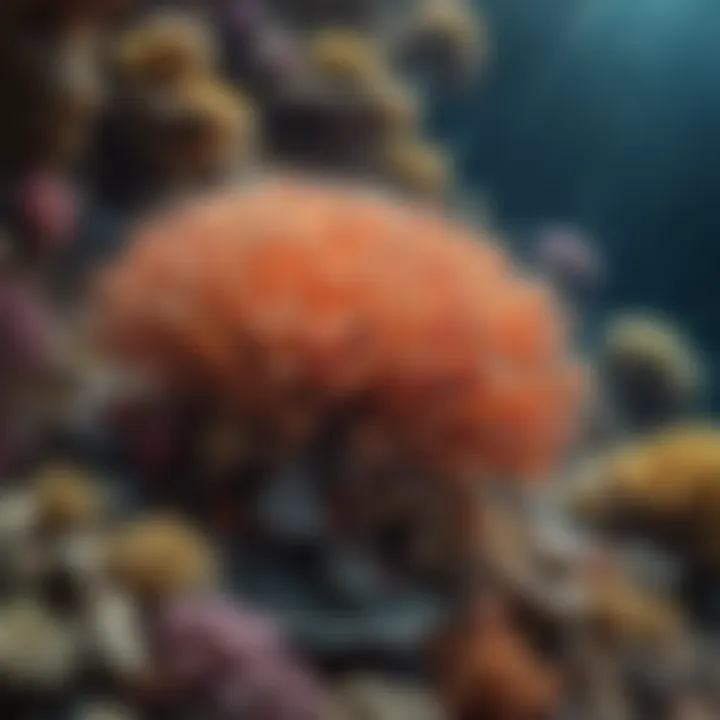
Technological Advancements in Coral Research
In today’s scientific landscape, technology plays a pivotal role in expanding our comprehension of reef-building corals. These advancements are not merely tools but gateways into understanding the intricate lives of these vital organisms. Coral research is evolving with innovative methods that enhance the study of their biology, ecology, and response to environmental stressors.
Remote Sensing Applications
The advent of remote sensing has transformed coral research in monumental ways. Through satellite and aerial imaging, researchers can monitor vast reef areas in a short span of time. This is particularly crucial for tracking changes in coral cover, bleaching events, and overall health of the reefs. Key benefits of these applications include:
- Large Scale Monitoring: Remote sensing enables scientists to assess coral distribution and health across entire regions.
- Early Detection of Stressors: By analyzing spectral data, researchers can detect changes linked to factors such as water temperature and sedimentation before they become significant threats.
- Modeling Coral Responses: Remote sensing data feeds into models that predict how coral reefs may react to future environmental changes, enhancing our preparedness.
Moreover, technologies like LiDAR (Light Detection and Ranging) allow scientists to penetrate the water surface to create highly detailed topographical maps of underwater environments. This helps in studying the physical structure of reefs, which is essential for understanding habitat complexity and biodiversity.
"Remote sensing has revolutionized our ability to monitor coral reefs, making it possible to study these ecosystems at scales and resolutions never before possible."
Genetic Research on Coral Resilience
Understanding the resilience of corals at a genetic level opens new avenues for conservation strategies. Recent advancements in genetic research provide insights into how different coral species withstand changing conditions. Key elements of this research include:
- Genomic Sequencing: With advancements in genome sequencing, scientists are uncovering the genetic blueprints of various coral species. This aids in identifying genetic markers associated with stress tolerance.
- Coral Hybridization: Research into hybrid corals, which arise when different species interbreed, has raised interesting questions about adaptability and resilience. These hybrids may possess unique traits that could help them survive extreme conditions.
- Microbiome Studies: The symbiotic relationship between corals and their associated microbial communities is gaining attention. Understanding how microbes influence coral health can lead to breakthroughs in improving coral resilience.
Efforts to combine genetic data with ecological studies promise a deeper understanding of coral responses to climate change.
As technology continues to evolve, the potential to safeguard coral ecosystems becomes increasingly tangible. The integration of cutting-edge tools and methodologies significantly enhances our capacity to protect these vital marine structures. By continually advancing our research techniques, scientists can unravel the mysteries of coral resilience and devise effective strategies for conservation.
Future Directions in Coral Research
Research centered on coral ecosystems is at a crucial juncture as the threats to these environments continue to escalate. Understanding the future direction of coral research is pivotal for not just the sustainability of coral reefs but also for the health of marine biodiversity as a whole. Given the complex interconnections in marine ecosystems, the findings from ongoing studies can potentially revolutionize conservation strategies. This section highlights some promising prospects and innovative techniques that could vastly improve our understanding of reef-building corals and their environments.
Integrative Approaches to Study Coral Ecosystems
To capture the complexity of reef systems, integrative research methods are essential. This approach combines various disciplines—biology, ecology, engineering, and even technology—to provide a holistic understanding of reef ecosystems. The ability to view corals through multiple lenses allows scientists to unravel intricate ecological relationships and stress responses. The following elements exemplify why integrating methods is beneficial:
- Interdisciplinary Collaboration: By involving diverse fields, researchers yield richer insights. Marine biologists might team up with chemists to study how chemical changes in the ocean affect coral health.
- Technology in Research: Advanced tools like underwater drones or remotely operated vehicles (ROVs) give scientists unprecedented access to reefs. They enable long-term monitoring of coral structures in real-time, leading to data that’s more accurate and timely.
- Data Integration: Utilizing big data analytics and machine learning can enhance research efficiency. Researchers can track environmental changes and coral health trends which are pivotal for effective conservation efforts.
By embracing an integrative approach, future research can enhance predictive models for coral resilience and guide conservation efforts more effectively.
Policy Implications and Global Cooperation
As the research landscape evolves, so does the necessity for robust policy frameworks that are rooted in scientific findings. Global cooperation becomes a keystone for effective coral conservation strategies. Some key aspects to consider include:
- International Agreements: Coral ecosystems are not confined to national borders. Treaties and agreements that promote collaborative research efforts and shared resources are crucial. Success stories like the Coral Triangle Initiative show how partnerships can yield significant conservation gains.
- Funding and Support for Research: Increased funding from governments and private sectors can fuel innovative projects. Policymakers should recognize the value of investing in coral research, as healthy reefs contribute to local economies through tourism and fisheries.
- Public Awareness and Education: An informed public is a powerful ally in conservation. Global cooperation must encompass educational initiatives that raise awareness about coral ecosystems and the dire consequences of their degradation.
Efforts to advance coral research and conservation should be unified on a global scale, breaking down silos that often hinder impactful action.
Understanding coral ecosystems necessitates collaborative efforts across regions and disciplines, making it vital to create integrated programs that address diverse needs and challenges.
As these future directions in coral research unfold, they hold the potential to illuminate paths toward restoration and sustainability of coral reefs. With an open line between researchers and policymakers, we can ensure that efforts are both informed and effective.
Finale: The Imperative of Coral Conservation
Corals, often seen through a lens of vibrant colors and dense marine life, are in reality the foundations of the ocean's ecosystems. Their conservation is not just crucial for marine biodiversity but also for the wellness of coastal communities and the global climate. In this article, we’ve treaded the intricate pathways that connect coral biology, ecology, and the multitude of challenges these organisms face. Understanding why protecting corals is imperative essentially boils down to a few key elements, each intertwined with the fabric of life and sustainability.
Biodiversity and Ecosystem Services
Coral reefs are among the most diverse ecosystems on the planet. They support an array of marine species—some estimates suggest up to 1 million different marine organisms can call a coral reef home. This biodiversity offers numerous benefits:
- Fishing: Many coastal communities depend on reef fish for their livelihoods.
- Tourism: Healthy reefs draw tourists, providing income and jobs.
- Coastal Protection: Reefs act as natural barriers that protect coastlines from waves and storms.
Each of these services is intrinsically linked to the health of coral. When corals decline, the entire system—including fish populations, tourism potential, and coastal resilience—faces jeopardy.
Indicators of Ocean Health
Corals serve as indicators of ocean health. Their presence and condition reflect broader environmental changes, especially in relation to climate change and pollution. Thermal stress, often a precursor to bleaching, signals that something’s amiss in the ecosystem. By monitoring coral health, scientists gain insights into the overall well-being of marine environments, guiding conservation efforts not just for corals but for the ocean at large.
"The health of coral reefs is a clear marker for the state of our oceans, as their deterioration can foreshadow larger environmental crises."
Climate Resilience
Climate change isn’t merely a distant worry; it’s impacting coral reefs now. With increasing ocean temperatures and acidification, corals struggle to survive. They possess remarkable resilience, yet this resilience has its limits. Understanding the factors that help corals adapt can help in conservation strategies.
Scientists are working on various technologies and methods, such as genetic research, to bolster coral resilience against these stressors. Further advancing these efforts can ensure that coral ecosystems endure the challenges posed by a changing climate.
Community and Cultural Connections
In many regions, corals are more than just biological entities; they hold cultural significance. Indigenous communities often have deep-rooted traditions connected to coral environments. This adds another dimension to conservation efforts, as preserving corals means safeguarding cultural heritage.







